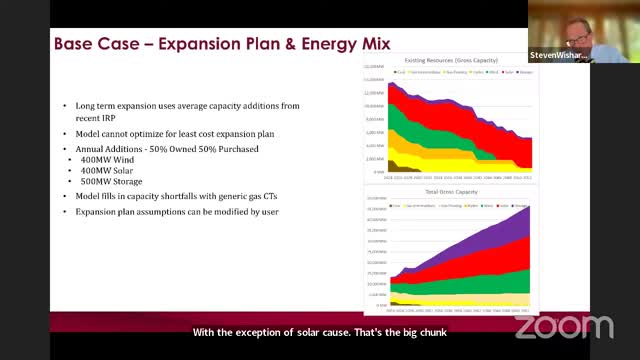Renewable investments drive dramatic rise in utility rates
July 26, 2024 | Public Utilities Commission, Governor's Boards and Commissions, Organizations, Executive, Colorado

This article was created by AI summarizing key points discussed. AI makes mistakes, so for full details and context, please refer to the video of the full meeting. Please report any errors so we can fix them. Report an error »

In a recent government meeting, officials discussed significant trends in energy resource management and financial projections for the utility sector. The conversation highlighted a shift towards renewable energy sources, particularly solar and wind, as coal and gas usage is expected to decline over time. The model presented indicated that while solar capacity is growing, it is being curtailed more frequently than wind due to operational strategies that prioritize wind generation when demand exceeds supply.
The meeting also addressed the financial implications of ongoing capital investments in the energy sector. Revenue requirements are projected to rise sharply, from approximately $404.5 billion to over $20 billion in the coming years. This increase is largely driven by a planned $17 billion capital investment, which is anticipated to yield a 6% annual growth rate from 2024 to 2030. However, officials cautioned that this growth could be tempered if some of the capital expenditures do not translate into operational assets.
Concerns were raised about the potential doubling of electric rates within the next decade, a scenario that could arise if capital investments continue at the current pace. The current electric rate base is estimated between $10 and $11 billion, with a notable increase in the five-year budget by approximately $8 to $9 billion. This substantial rise has prompted questions about regulatory oversight and the timeline for public review of these financial changes.
Despite the challenges, there is optimism regarding the impact of renewable energy investments. Officials noted that capital spent on renewable projects, such as wind farms, could lead to significant fuel savings, potentially offsetting some of the anticipated rate increases. The discussions underscored the importance of balancing capital investment with sustainable energy practices to ensure long-term viability and affordability in the utility sector.
The meeting also addressed the financial implications of ongoing capital investments in the energy sector. Revenue requirements are projected to rise sharply, from approximately $404.5 billion to over $20 billion in the coming years. This increase is largely driven by a planned $17 billion capital investment, which is anticipated to yield a 6% annual growth rate from 2024 to 2030. However, officials cautioned that this growth could be tempered if some of the capital expenditures do not translate into operational assets.
Concerns were raised about the potential doubling of electric rates within the next decade, a scenario that could arise if capital investments continue at the current pace. The current electric rate base is estimated between $10 and $11 billion, with a notable increase in the five-year budget by approximately $8 to $9 billion. This substantial rise has prompted questions about regulatory oversight and the timeline for public review of these financial changes.
Despite the challenges, there is optimism regarding the impact of renewable energy investments. Officials noted that capital spent on renewable projects, such as wind farms, could lead to significant fuel savings, potentially offsetting some of the anticipated rate increases. The discussions underscored the importance of balancing capital investment with sustainable energy practices to ensure long-term viability and affordability in the utility sector.
View full meeting
This article is based on a recent meeting—watch the full video and explore the complete transcript for deeper insights into the discussion.
View full meeting
